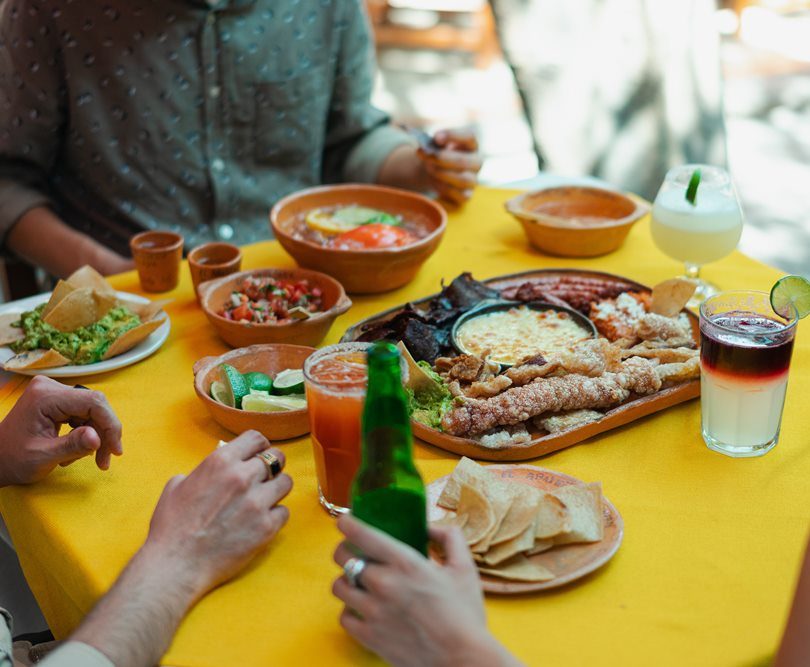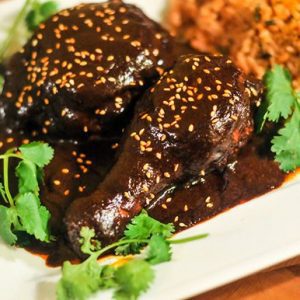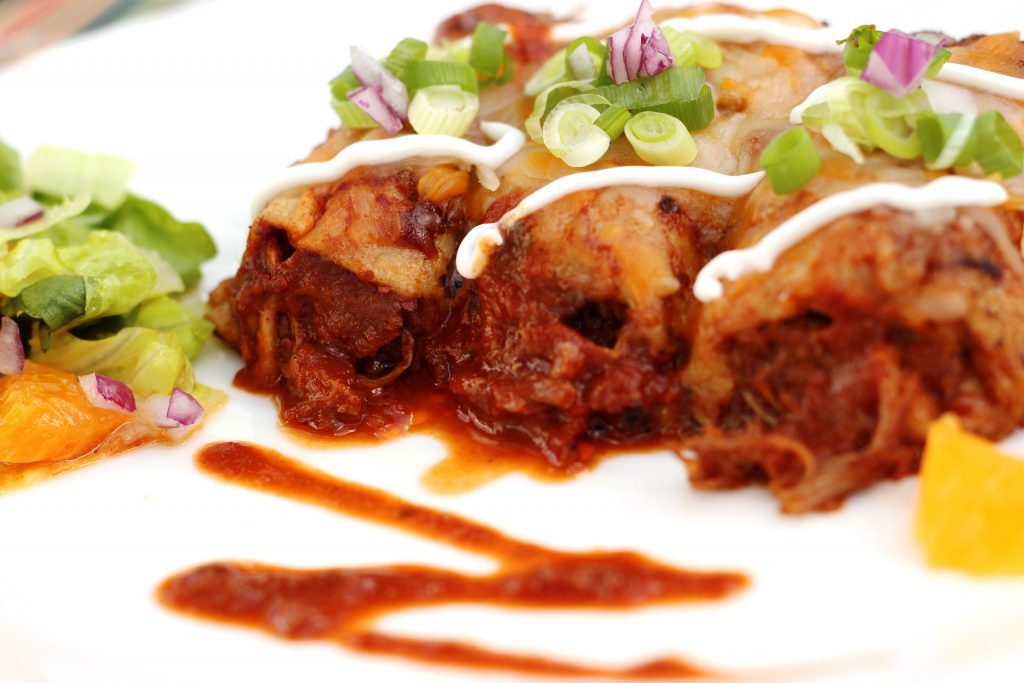We started to plan our annual Cinco de Mayo party, when we started to question – what do we really know about Cinco de Mayo? What are the real foods eaten in Mexico for Cinco de Mayo? And where are the margaritas (check out FOOD52 for absolutely the best margaritas recipes)? Here we share 7 dishes you will want to try for Cinco de Mayo, or any time you get the itch to delve a bit into the rich history of Mexican food.
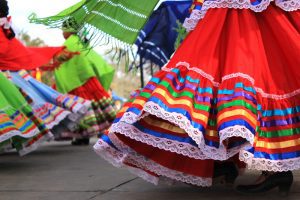
Colorful skirts fly during traditional Mexican dancing – Shutterstock
Many in the US who do not have Mexican roots believe Cinco de Mayo is Mexico’s Independence Day – it is not. Cinco de Mayo celebrates the Mexican victory at the Battle of Puebla during the Franco-Mexican War, which came after Mexico’s independence from Spain, and happened during the American Civil War. This holiday is mainly celebrated in the region of Puebla, and mostly in the state’s capital city of the same name. It was made into a much larger celebration in the US, having its US roots in California. Once we found out that the holiday centers around the state of Puebla, we wanted to find out what Mexicans from Puebla eat on Cinco de Mayo (by the way, well-renowned chefs like Rick Bayless consider Puebla a culinary mecca for Mexican food).
While researching the holiday, we came across a very excellent article by Shaylyn Esposito on the Smithsonian Magazine website: What to Really Eat on Cinco de Mayo. Ms. Esposito headlines Mole Poblano as the most consumed dish in Puebla for Cinco de Mayo. So we’ll start with Mole Poblano.
Mole Poblano
Many people are scared of Mexican mole – somehow, they equate “mole” with a sweet chocolate bar tasting sauce – so what does authentic mole poblano taste like? Mole Poblano is mildly spicy, slightly tangy, and full of umami. It’s a sauce that is most often used on meat (usually chicken, turkey, or duck). A good mole doesn’t taste like chocolate at all; it just one of the many background flavors that adds to the over-all umami. The word “mole” just means sauce and is either derived from the Azetc word mulli, or from the Spanish word moler, which means to grind (since classically, much of the ingredients are ground together). Whichever story you want to believe, mole is a sauce made from ground up ingredients and comes in all colors and consistencies, but the thick dark sauce for mole poblano is classic. There are many great recipes for mole – you should start with Rick Bayless’ Beginner’s Mole recipe. We also love Pati Jinich’s mole poblano recipe (Pati’s Mexican Table), and we obsessively watch every episode, and take notes. And we do have a very simple cheat – Serious Foodie has a very popular Mexican Mole, made from fresh Mexican peppers. We recently made a spit-roasted duck, using the Serious Foodie Mexican Mole as a marinade, basted the duck (like a bbq sauce), and used it as a dipping sauce while serving. Check out our recipe for a very simple Mole Chicken.
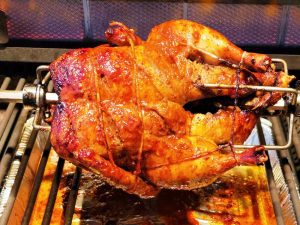
Spit-Roasted Duck with Mexican Mole
Chalupas
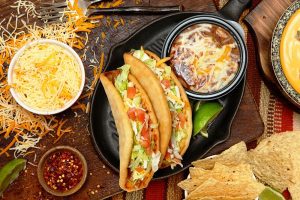
Classic Puebla Chalupas
A lot of the foods for the Cinco de Mayo celebration in Puebla are antojito – small bites or street food. Chalupas are an iconic Poblano street food, have a resemblance to tostadas and are the perfect antojito for any Cinco de Mayo celebration. To put it simply, chalupas are fried thick tortillas (corn) topped with salsa, shredded meat, chopped onion and sometimes queso fresco.
There are two versions to the history of chalupas. The first is that it gets its name from baskets. According to All About Puebla, Chalupas date back to Colonial times, when Spanish settlers spent a good part of their days washing clothes by the Almoloya (San Francisco) River. It’s said that the women carried everything to the river in big baskets made of wood called chalupas, after which they’d rush home and quickly fry up corn tortillas in lard, top them with salsa, shredded beef or pork, and chopped onion – and call it dinner. We found quite a few easy chalupa recipes:
- Garlic and Zest – Authentic Mexican Chalupas
- Uno Casa – Chalupa vs. Taco Mexican Street Food Stand-off
- The Tortilla Channel – How to Make Chalupas
We have our own take on this dish – and our preferred filling is either pulled chicken (recipe found HERE) or pulled pork (recipe found HERE).
Barbacoa
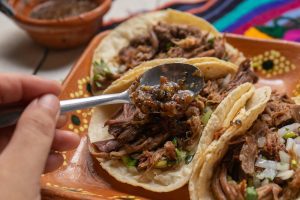
Traditional Mexican barbacoa lamb tacos
Is barbacoa just barbecue? Well, yes and no.
It is one of the oldest cooking methods, and maybe the most loved, in Mexico. The Mexican method always uses some sort of large leaves (agave, or banana), which reminds us so much of kalua pork in Hawaii. This method is more like steaming/braising than roasting, and not like the Carolina whole hog barbecue, or the Caribbean barbacoa, which is cooked in the open air. If you want a full history, take a look at the article on Food Network by Carlos C. Olaechea. He also talks about the difference between barbacoa and birria.
According to Wikipedia, “Barbacoa is a form of cooking meat that originated in present day Puerto Rico with the Taíno people, who called it barbaca, from which the term “barbecue” derives. In contemporary Mexico, it generally refers to meats or whole sheep or whole goats slow-cooked over an open fire or, more traditionally, in a hole dug in the ground covered with agave (maguey) leaves, although the interpretation is loose, and in the present day (and in some cases) may refer to meat steamed until tender. This meat is known for its high fat content and strong flavor, often accompanied with onions and cilantro.”
We don’t usually see someone digging a hole in the ground to do their barbacoa, or barbecue, in Florida. And there has to be an easier hack to get a great result, fitting for Cinco de Mayo or any time.
Turns out that a slow cooker works just fine for getting a great result. One of the better recipes we’ve seen is by Rick Bayless – Lamb Barbacoa. And besides, who has the time to work with whole goat or whole sheep? We’ve tried his recipe using lamb shanks, which are meaty and delicious – and the result was outstanding. My Latin Table also has a slow cooker recipe using beef instead of lamb, and is just as easy of the Bayless recipe.
Enchiladas
To cut through the confusion, an enchilada is, according to Wikipedia, “… a corn tortilla rolled around a filling and covered with a savory sauce. Originally from Mexican cuisine, enchiladas can be filled with various ingredients, including meats, cheese, beans, potatoes, vegetables, or combinations. Enchilada sauces include chili-based sauces, such as salsa roja, various moles, or cheese-based sauces, such as chile con queso.” So don’t use flour tortillas – it won’t be an enchilada if you do.
In other words, find yourself some high-quality corn tortillas (or better yet, make your own), then fill them with whatever you like. If you want to make your own tortillas, check out the Inspired Taste website, or the folks at Mexican Please, for a tutorial. They’re really easy, and worth the little bit of effort.
GimmeSomeOven has a fun recipe called Hole Mole Enchiladas, and a 20-minute mole that is delicious. We also like Once Upon a Chef’s easy beef enchiladas.
And, just in case you missed it, Serious Foodie has a fun, easy, healthy version of Pulled Pork Enchiladas.
Carnitas
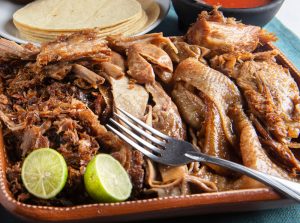
Mexican carnitas
We see carnitas on every menu, even chains like Chipotle. Does it just mean shredded meat? Nope – the most accurate definition is pork made by braising or simmering in oil – and the word literally meaning “little meats” in Spanish, which makes some sense since it is always shredded.
In many ways, carnitas is very similar to the version we’ve made for our Pulled Pork Enchiladas. Like everything we make, the quality of ingredients make all the difference in the world. For our carnitas, we always start with pork shoulder. We season it well, and let it sit for at least a few hours in the refrigerator to marinate. PopSugar has an excellent explanation on the differences between carnitas, carne asada, al pastor, barbacoa, and cochinita pibil. Now you know.
So, as a starting point, try out the slow cooker recipe for carnitas at PopSugar. Our go-to main-man-about-Mexican-cooking Rick Bayless has an excellent, amazingly flavorful version that uses an oven-roast method. And we really liked the pictures and the videos from KevinIsCooking.
Mexican Street Corn
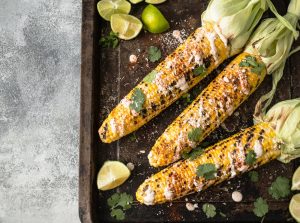
Grilled corn cobs with coriander, lime, paprika and cheese.
Elotes – better known as the classic Mexican street food: Corn on the cob charred on the grill, then slathered in a spicy and creamy chili, garlic, and Cotija cheese. It’s so easy, and so delicious that you’ll be a quick convert to this way to serve corn. And, across the US, fresh corn can usually be found at least 6 months out of the year.
The basic idea – which is the thought behind all that we do at Serious Foodie – is to find a great ingredient and serve it in the best way possible. Start out with really great corn, grill it to perfection, and add some complementary toppings. Good butter works. Mexican crema works. But when you add all the ingredients of elotes, you get…MAGIC! Try our recipe HERE.
There are many ways to grill corn, but in this case, you want to go with fully shucked cobs, cooked directly over very hot coals. If all goes well, the corn should be completely cooked through just as it begins to char, rendering each kernel bursting with sweet juice, with a rich, nutty flavor from the toasting. Medium high heat, cooked about 2-3 minutes, then turn over for another 2-3 minutes.
We have our own version of this recipe that you can access at Serious Foodie, and there are a number of other recipes that also work quite well:
Chilaquiles
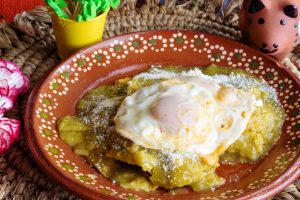
Mexican chilaquiles with over medium eggs, with sour cream and cheese
We saved the best (and the beginning) for last. Chilaquiles is a great dish to start your Cinco de Mayo, or maybe you want to wait until the next morning – it’s also a great hangover cure. Well, maybe not necessarily a cure, but it is a delicious way to start any day.
Chilaquiles is always made with corn tortillas – and it is a theme of this whole article. Forget the store bought stuff with lots of ingredients you can’t pronounce. Go get some real corn tortillas, hopefully made fresh that day at your local Hispanic grocery. Or make them yourself. They’re just masa (corn flour) and water. Easy/peasy. YouTube has lots of how-to videos.
The basis of chilaquiles (which means chilies and greens) is simple: lightly fried corn tortillas, add some salsa (red or green), add some avocado or guacomole, some cheese, a fried egg – and there you go! Chilaquiles, everybody!
Our go-to recipe is, of course, Rick Bayless’s chilaquiles verdes. And we really like the red version by Vianney Rodriguez on the Kitchn.com website (nice recipe, nice video). The MexicanFoodJournal adds pulled chicken, making it a more hearty dish – and we liked it!
Have we missed anything? What is your favorite Cinco de Mayo food or drink? Let us know!
Check out all of our amazing regional specialty sauces and spice rubs at our shop: Serious-Foodie.com/Shop.

